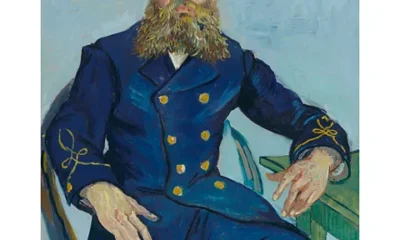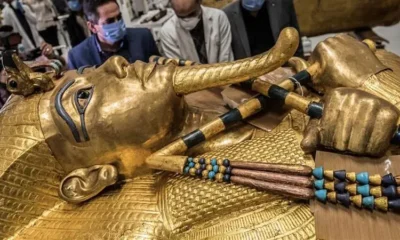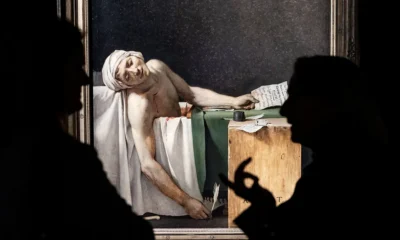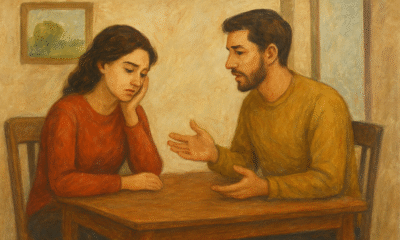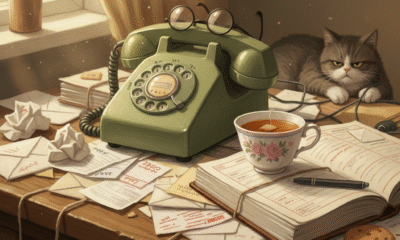Art & Culture
‘Paintings were suddenly seen as money’: The reason art heists exploded in the 1970s

Acclaimed new film The Mastermind, starring Josh O’Connor, tells the story of an art robbery gone wrong. It’s inspired by a wave of similar thefts during a decade known for upheaval.
In May 1972, two men walked into the Worcester Art Museum in Massachusetts and hurried out carrying four paintings by Paul Gauguin, Pablo Picasso and a supposed Rembrandt (now believed to be the work of one of his students), holding a group of visiting high school students at gunpoint and shooting a security guard in the process. With the stolen artworks’ worth tallying up to $2m (£1.5m), the New York Times ranked it among “the largest art robberies in modern times”. Some say it even inspired a far more famous crime nearby: the 1990 heist at Boston’s Isabella Stewart Gardner Museum, in which $500m (£370m) of art was looted, making it the costliest theft in US history full stop, with the crime remaining unsolved.
The Worcester heist was orchestrated by career criminal Florian “Al” Monday, but the game was up after the two thieves he hired for the raid boasted about their exploits in their local bar. Within a month, the paintings were safely retrieved from a pig farm in Rhode Island and returned to the gallery. “Ironically, Monday – before he was an art thief – had a band, and I have the 45 of his record,” writer-director Kelly Reichardt tells the BBC. Her new film The Mastermind, which is released in the US this weekend, is loosely inspired by the chain of events that followed the Worcester robbery, as well as the wave of art heists that followed over the course of that decade.
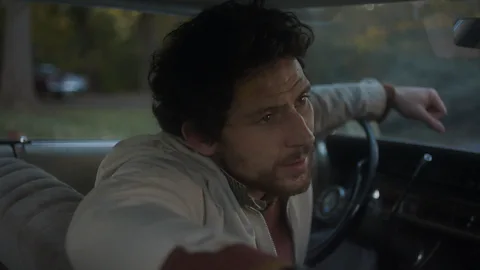
Praised by The Guardian’s film critic Peter Bradshaw for locating “the unglamour in the heist”, Reichardt’s thoughtful art crime caper dismantles the usual rules of the glitzy, sensationalised heist movie. Blockbusters have long popularised the idea that there is something classy about this category of crime, particularly when it involves art: think, for example, of the 1999 version of The Thomas Crown Affair, in which Pierce Brosnan plays a very suave billionaire orchestrating a raid on New York’s Metropolitan Museum of Art.
Reichardt’s take on the genre adopts a slower pace and more exacting eye for the way in which its art robbery cataclysmically unfolds. Josh O’Connor takes the title role as the brains behind the operation: JB Mooney, a middle-class, well-educated art school drop-out now ailing as an underemployed carpenter in Massachusetts. Under pressure from his well-to-do parents – a retired judge (Bill Camp) and a socialite (Hope Davis) – to repay their loans to him, he cases the fictional Framingham Art Museum for a heist. But from the moment that one of his henchmen asks how he plans to sell on the stolen paintings – which would be difficult due to their recognisability – the scheme begins to go awry.
If you start to get down into the minutiae of a robbery like this and don’t concentrate on the bigger strokes, then by nature it becomes de-glamorised – Kelly Reichardt
Reichardt came across an article about the 50-year anniversary of the Worcester Art Museum robbery while working on her previous film, Showing Up (2002), a comedy drama about two rival sculptors, and decided to use the story as the foundation of her next feature. All that was left to do was to create the character of JB. “The political ideas, the genre ideas – these are things you think about and study, but then you have to let go of all that and concentrate on the details of the film you’re making with what your character situation is like,” says Reichardt. “If you start to get down into the minutiae of those things and don’t concentrate on the bigger strokes, then by nature it [becomes] de-glamorised.”
Reading about the 1972 robbery brought back memories for Reichardt of the “many smash-and-grabs at the time” that frequently appeared in newspaper headlines. Mere months after the Worcester Art Museum heist, a robbery since dubbed the “skylight caper” took place in Canada – the Montreal Museum of Fine Arts was raided by three armed robbers, who clinched $2m (£1.5m) of paintings, jewels and valuable objects, marking the largest theft in the nation’s history. Across the Atlantic, in 1976, 119 of Picasso’s final works were pilfered from France’s Palais des Papes by three thieves while they were on show during a visiting exhibition.
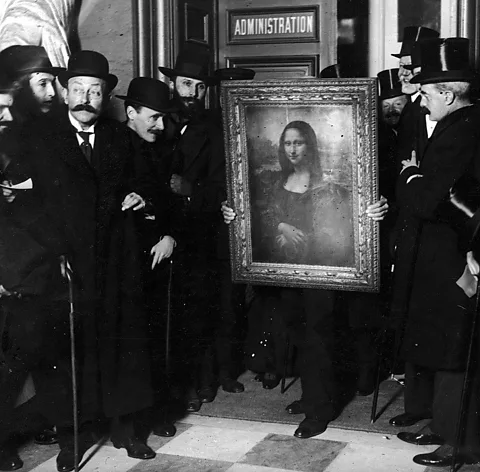
Then there was the case of Rose Dugdale, an Oxford University graduate and heiress turned fierce Irish republican, who was the focus of Joe Lawlor and Christine Molloy’s high-octane 2023 art-heist drama Baltimore. In 1974, together with several IRA members, she took 19 paintings by the likes of Johannes Vermeer and Peter Paul Rubens from Ireland’s Russborough House, and held them to ransom, hoping for the release of imprisoned IRA members. Lawlor told Cineuropa: “There was something incredibly well organised about it and really badly thought out. They are so driven but completely blind to the wider political reality.”
The history of art theft
Before this spate of burglaries, history had seen countless other lootings and plunderings of prized art pieces, from the 1473 theft by pirates of Hans Memling’s The Last Judgment from a ship bound for Florence, to the infamous purloining of the Mona Lisa from the Louvre in 1911 by Vincenzo Peruggia, an embittered former employee at the gallery. When he was caught two years later, he only served a six-month prison sentence.
Yet the Massachusetts robbery undeniably signalled a gear change for the art heist industry. According to art historian Tom Flynn, the surge in heists in the 1970s “coincides with the boom of the art market”. Citing the 1977 launch of Antiques Roadshow – the long-running BBC TV show in which a team of experts appraise art pieces and objects – and its ensuing popularity, Flynn adds: “It’s a cultural change where we start to see works of art as the equivalent of money.”
Meanwhile, criminals were becoming aware of the flimsiness of museum security, making works of art seem an easy target. News reports in the early 1970s warned of funding “crises” for museums and cutbacks in security, particularly amid high inflation. Smaller-scale thefts, such as the stealing of Francisco Goya’s portrait of the Duke of Wellington from London’s National Gallery in 1961 and the disappearance of three Rembrandts from Dulwich Picture Gallery in 1966, revealed how straightforward it could be simply to lift a painting from gallery walls undetected.
Part of the appeal of these characters is their outsmarting the establishment. The fact that art heists usually don’t involve private individuals makes it more acceptable – Susan Ronald
Like the guard injured during the Worcester Art Museum robbery, security employees rarely carried arms – and, as portrayed mockingly in The Mastermind, they could often be dozy “retirees” or “acid heads”, as Reichardt says, with limited training. She adds: “Museums used to have these cool circular drives out front, which made the getaway pretty handy.” And, while the film features an FBI art crime investigator reminiscent of real-life agent Robert Wittman – who recovered $300m (£225m) worth of art over the course of his career – the actual FBI Art Crime Team was only founded in 2004.
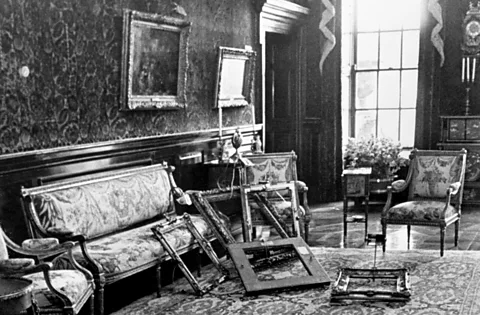
But as Flynn notes, while museums may have been slow to appreciate the threat of robbery in the past, the robbers have not generally displayed the sharpest acumen either. “The history of art crime and major art heists has been one of opportunist idiots who don’t really understand the nature of works of art themselves,” he says, referring to their potential for damage, “or indeed the market for works of art. [Then] these guys suddenly discover, to their horror, that the objects they’ve stolen are very difficult things to shift.”
The allure of the art robber
An archetype in fiction of the art robber as lovable rogue also started to emerge during the 1960s and ’70s. Amid unrest driven by the Vietnam War and the Nixon administration, disillusionment and discontent reached high levels, especially among younger generations in the US. Simultaneously, films such as 1964’s Topkapi (where a band of art thieves attempt to steal from a palace in Istanbul), 1966’s How to Steal a Million (where Audrey Hepburn and Peter O’Toole plan a heist to altruistic ends) and the same year’s Gambit (starring Michael Caine as a plucky cat burglar stealing an antique bust) helped to glamorise such characters.
According to historical author Susan Ronald, who specialises in art crime, the rise of the art robber in pop culture reflects the time’s anti-authority mentality. “Part of [the appeal of these characters] is [their] outsmarting the establishment,” she explains. “The fact that art heists usually don’t involve private individuals makes it more acceptable. It’s an institution, and there’s something quite daring about it.”
Perhaps it’s partly down to the glorification of these art stealers that misconceptions about arts heists have taken root – for example, the idea of them being a “victimless crime”. “We don’t take it seriously enough,” says Flynn, “which is why the criminals quite often get ridiculous [short] sentences when you consider that they’ve committed a serious cultural crime. But because it’s art, we don’t think it’s so important.”
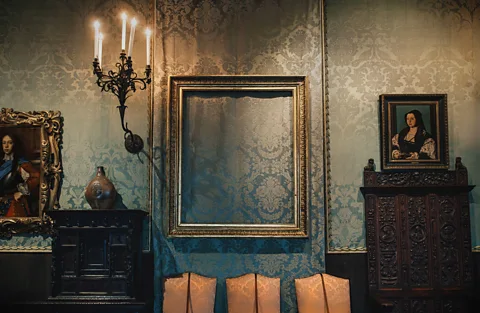
The Mastermind works in many ways to upend entrenched ideas about art robbers. From Caine in Gambit to Alain Delon in Jean-Pierre Melville’s Le Cercle Rouge (1970), such a figure was often represented as a heartthrob in the films of that time. But, with JB, Reichardt hoped to subvert that. “These guys are [actually] such jerks. They’re misogynist. They can afford to break away and do what they want. They’re not pinned down with kids. Just the idea of being able to be the outlaw is a privilege, but in the end you root for them, it’s just a narrative thing.”
More like this:
• Meet the world’s greatest art detective
• 12 of the best films to watch this October
• Why 1971 was an extraordinary film year
We get a nuanced perspective on JB’s character through his long-suffering wife, Terri (Alana Haim), and unimpressed fellow graduate Maude (Gaby Hoffman), both forced to put up with his antics. “There is an added, more objective look at him at times through the women in JB’s life who he counts on, who are taxed by his freedom. Personal freedom being a huge theme in American politics today – but at what cost and who carries the weight of that?”
Today, robberies of public museums and galleries are far less frequent, with criminals now “cottoned on to the fact that these are essentially non-fungible objects”, says Flynn. However, recent funding cuts by the US government could spell a troubling future for museum security again – even if there are bigger threats to paintings these days, says heritage consultant Vernon Rapley. “It’s not just security that will suffer – it will be the very fabric of the buildings as well. If you don’t invest in your roofs and windows, then ultimately, weather and climate change are probably a greater risk to objects, in fact, than criminals are.”
The Mastermind is released in US cinemas on 17 October and UK cinemas on 24 October
Art & Culture
“Confessions Beneath the Barrel” A city mourns as a poet captures the terror within a man’s own making—a chilling reflection on Karachi’s fractured heart.

Possessed by the devil,
I strode out to do evil.
With enmity written large on my face,
Somebody has to be dad in deaths embrace.
Just yesterday a child became an orphan,
And a couple were worried by the ransoms burden.
The fetters of depression behold the city,
Where everyday criminals like me enter captivity.
Karachi, Karachi of yore
Shall hot surface will not surface
Whilst I trigger my double barrel bore.
Art & Culture
‘A very deep bond of friendship’: The surprising story of Van Gogh’s guardian angel
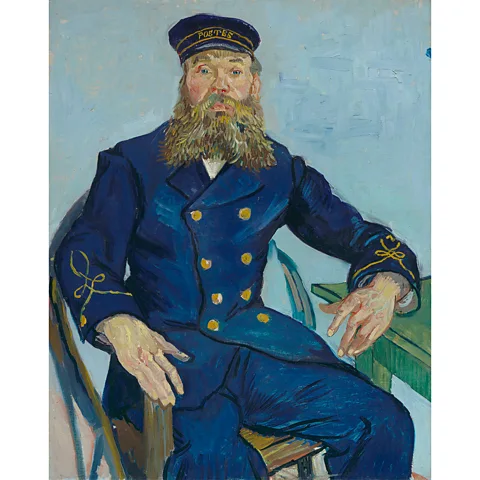
At the toughest, most turbulent time of his life, the Post-Impressionist painter was supported by an unlikely soulmate, Joseph Roulin, a postman in Arles. A new exhibition explores this close friendship, and how it benefited art history.
On 23 December, 1888, the day that Vincent van Gogh mutilated his ear and presented the severed portion to a sex worker, he was tended to by an unlikely soulmate: the postman Joseph Roulin.
A rare figure of stability during Van Gogh’s mentally turbulent two years in Arles, in the South of France, Roulin ensured that he received care in a psychiatric hospital, and visited him while he was there, writing to the artist’s brother Theo to update him on his condition. He paid Van Gogh’s rent while he was being cared for, and spent the entire day with him when he was discharged two weeks later. “Roulin… has a silent gravity and a tenderness for me as an old soldier might have for a young one,” Van Gogh wrote to Theo the following April, describing Roulin as “such a good soul and so wise and so full of feeling”.
Paying homage to this touching relationship is the exhibition Van Gogh: The Roulin Family Portraits, opening at the MFA Boston, USA, on 30 March, before moving on to its co-organiser, the Van Gogh Museum, Amsterdam, in October. This is the first exhibition devoted to portraits of all five members of the Roulin family. It features more than 20 paintings by Van Gogh, alongside works by important influences on the Dutch artist, including 17th-Century Dutch masters Rembrandt and Frans Hals, and the French artist Paul Gauguin, who lived for two months with Van Gogh in Arles.
Roulin wasn’t just a model for Van Gogh – this was someone with whom he developed a very deep bond of friendship – Katie Hanson
“So much of what I was hoping for with this exhibition is a human story,” co-curator Katie Hanson (MFA Boston) tells the BBC. “The exhibition really highlights that Roulin isn’t just a model for him – this was someone with whom he developed a very deep bond of friendship.” Van Gogh’s tumultuous relationship with Gauguin, and the fallout between them that most likely precipitated the ear incident, has tended to overshadow his narrative, but Roulin offered something more constant and uncomplicated. We see this in the portraits – the open honesty with which he returns Van Gogh’s stare, and the mutual respect and affection that radiate from the canvas.
A new life in Arles
Van Gogh moved from Paris to Arles in February 1888, believing the brighter light and intense colours would better his art, and that southerners were “more artistic” in appearance, and ideal subjects to paint. Hanson emphasises Van Gogh’s “openness to possibility” at this time, and his feeling, still relatable today, of being a new face in town. “We don’t have to hit on our life’s work on our first try; we might also be seeking and searching for our next direction, our next place,” she says. And it’s in this spirit that Van Gogh, a newcomer with “a big heart“, welcomed new connections.
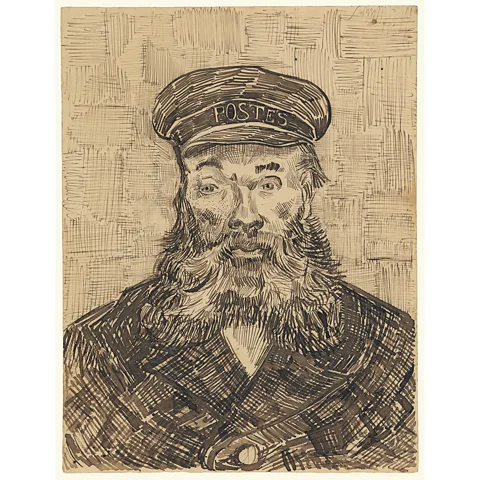
Before moving into the yellow house next door, now known so well inside and out, Van Gogh rented a room above the Café de la Gare. The bar was frequented by Joseph Roulin, who lived on the same street and worked at the nearby railway station supervising the loading and unloading of post. Feeling that his strength lay in portrait painting, but struggling to find people to pose for him, Van Gogh was delighted when the characterful postman, who drank a sizeable portion of his earnings at the café, agreed to pose for him, asking only to be paid in food and drink.
ADVERTISING
Between August 1888 and April 1889, Van Gogh made six portraits of Roulin, symbols of companionship and hope that contrast with the motifs of loneliness, despair and impending doom seen in some of his other works. In each, Roulin is dressed in his blue postal worker’s uniform, embellished with gold buttons and braid, the word “postes” proudly displayed on his cap. Roulin’s stubby nose and ruddy complexion, flushed with years of drinking, made him a fascinating muse for the painter, who described him as “a more interesting man than many people”.
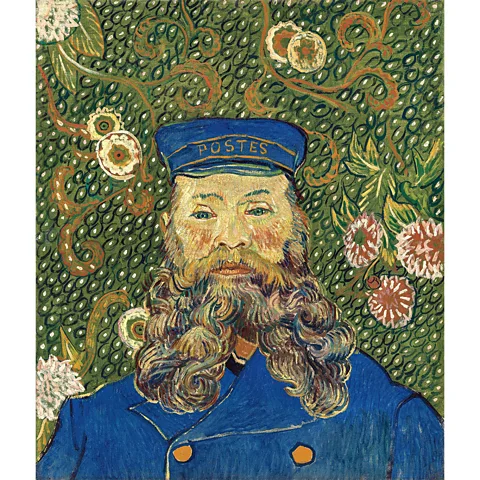
Roulin was just 12 years older than Van Gogh, but he became a guiding light and father figure to the lonely painter – on account of Roulin’s generous beard and apparent wisdom, Van Gogh nicknamed him Socrates. Born into a wealthy family, Van Gogh belonged to a very different social class from Roulin, but was taken with his “strong peasant nature” and forbearance when times were hard. Roulin was a proud and garrulous republican, and when Van Gogh saw him singing La Marseillaise, he noticed how painterly he was, “like something out of Delacroix, out of Daumier”. He saw in him the spirit of the working man, describing his voice as possessing “a distant echo of the clarion of revolutionary France”.
The friendship soon opened the door to four further sitters: Roulin’s wife, Augustine, and their three children. We meet their 17-year-old son Armand, an apprentice blacksmith wearing the traces of his first facial hair, and appearing uneasy with the painter’s attention; his younger brother, 11-year-old schoolboy Camille, described in the exhibition catalogue as “squirming in his chair”; and Marcelle, the couple’s chubby-cheeked baby, who, Roulin writes, “makes the whole house happy”. Each painting represents a different stage of life, and each sitter was gifted their portrait. In total, Van Gogh created 26 portraits of the Roulins, a significant output for one family, rarely seen in art history.
Van Gogh had once hoped to be a father and husband himself, and his relationship with the Roulin family let him experience some of that joy. In a letter to Theo, he described Roulin playing with baby Marcelle: “It was touching to see him with his children on the last day, above all with the very little one when he made her laugh and bounce on his knees and sang for her.” Outside these walls, Van Gogh often experienced hostility from the locals, who described him as “the redheaded madman”, and even petitioned for his confinement. By contrast, the Roulins accepted his mental illness, and their home offered a place of safety and understanding.
The relationship, however, was far from one-sided. This educated visitor with his unusual Dutch accent was unlike anyone Roulin had ever met, and offered “a different kind of interaction”, explains Hanson. “He’s new in town, new to Roulin’s stories and he’s going to have new stories to tell.” Roulin enjoys offering advice – on furnishing the yellow house for example – and when, in the summer of 1888, Madame Roulin returned to her home town to deliver Marcelle, Roulin, left alone, found Van Gogh welcome company.
Roulin also got the rare opportunity to have portraits painted for free, and when, the following year, he was away for work in Marseille, it comforted him that baby Marcelle could still see his portrait hanging above her cradle. His fondness for Van Gogh shines through their correspondence. “Continue to take good care of yourself, follow the advice of your good Doctor and you will see your complete recovery to the satisfaction of your relatives and your friends,” he wrote to him from Marseille, signing off: “Marcelle sends you a big kiss.”
Van Gogh lived a further 19 months, producing a staggering 70 paintings in his last 70 days, and leaving one of art history’s most treasured legacies
Van Gogh’s portraits placed him in the heart of the family home. In his five versions of La Berceuse, meaning both “lullaby” and “the woman who rocks the cradle”, Mme Roulin held a string device, fashioned by Van Gogh, that rocked the baby’s cradle beyond the canvas, permitting the pair the peace to complete the artwork. The joyful background colours – green, blue, yellow or red – vary from one family member to another. Exuberant floral backdrops, reserved for the parents, come later, conveying happiness and affection – a blooming that took place since the earlier, plainer portraits.
Art history has also greatly benefitted from the freedom this relationship granted Van Gogh to experiment with portraiture, and to develop his own style with its delineated shapes, bold, glowing colours, and thick wavy strokes that make the forms vibrate with life. In the security of this friendship, he overturned the conventions of portrait painting, prioritising an emotional response to his subject, resolving “not to render what I have before my eyes” but to “express myself forcefully”, and to paint Roulin, he told Theo, “as I feel him”.
Had Van Gogh not felt Roulin’s unwavering support, he may not have survived the series of devastating breakdowns that began in December 1888 when he took a razor to his ear. With the care of those close to him, he lived a further 19 months, producing a staggering 70 paintings in his last 70 days, and leaving one of art history’s most treasured legacies.
Like the intimate portraits he created in Arles, the exhibition courses with optimism. “I hope being with these works of art and exploring his creative process – and his ways of creating connection – will be a heartwarming story,” Hanson says. Far from “shying away from the sadness” of this period of Van Gogh’s life, she says, the exhibition bears witness to the power of supportive relationships and “the reality that sadness and hope can coexist”.
Van Gogh: The Roulin Family Portraits is at the Museum of Fine Arts, Boston from 30 March to 7 September 2025, and at the Van Gogh Museum, Amsterdam from 3 October 2025 to 11 January 2026.
—
If you liked this story, sign up for The Essential List newsletter – a handpicked selection of features, videos and can’t-miss news, delivered to your inbox twice a week.
For more Culture stories from the BBC, follow us on Facebook, X and Instagram.
Art & Culture
Egypt’s Grand Museum opens, displaying Tutankhamun tomb in full for first time

Yolande Knell, Middle East correspondent, Reporting fromin Cairo, and Wael Hussein, Reporting fromin Cairo
- Published1 November 2025, 01:19 GMT
Near one of the Seven Wonders of the Ancient World – the Great Pyramid of Khufu at Giza – Egypt is officially opening what it intends as a cultural highlight of the modern age.
The Grand Egyptian Museum (GEM), described as the world’s largest archaeological museum, is packed with some 100,000 artefacts covering some seven millennia of the country’s history from pre-dynastic times to the Greek and Roman eras.
Prominent Egyptologists argue that its establishment strengthens their demand for key Egyptian antiquities held in other countries to be returned – including the famed Rosetta Stone displayed at the British Museum.
A main draw of the GEM will be the entire contents of the intact tomb of the boy king Tutankhamun, displayed together for the first time since it was found by British Egyptologist Howard Carter. They include Tutankhamun’s spectacular gold mask, throne and chariots.
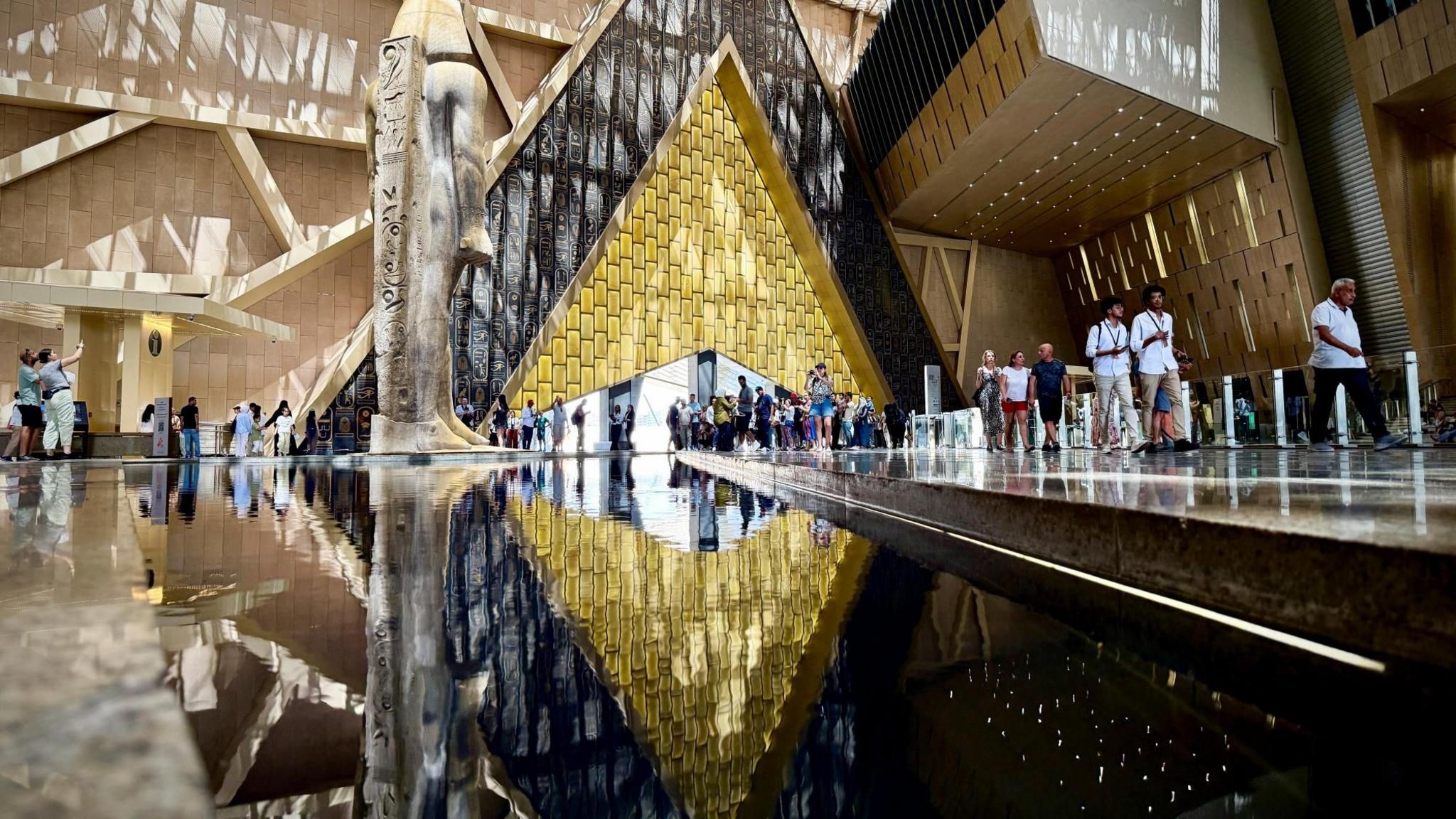
“I had to think, how can we show him in a different way, because since the discovery of the tomb in 1922, about 1,800 pieces from a total of over 5,500 that were inside the tomb were on display,” says Dr Tarek Tawfik, president of the International Association of Egyptologists and former head of the GEM.
“I had the idea of displaying the complete tomb, which means nothing remains in storage, nothing remains in other museums, and you get to have the complete experience, the way Howard Carter had it over a hundred years ago.”
Costing some $1.2bn (£910m; €1.1bn), the vast museum complex is expected to attract up to 8m visitors a year, giving a huge boost to Egyptian tourism which has been hit by regional crises.
“We hope the Grand Egyptian Museum will usher in a new golden age of Egyptology and cultural tourism,” says Ahmed Seddik, a guide and aspiring Egyptologist by the pyramids on the Giza Plateau.
Apart from the Tutankhamun exhibit and a new display of the spectacular, 4,500-year-old funerary boat of Khufu – one of the oldest and best-preserved vessels from antiquity – most of the galleries at the site have been opened to the public since last year.
“I’ve been organising so many tours to the museum even though it was partially open,” Ahmed continues. “Now it will be at the pinnacle of its glory. When the Tutankhamun collection opens, then you can imagine the whole world will come back, because this is an iconic Pharoah, the most famous king of all antiquity.”
“It’s an absolute must-see,” says Spanish tourist, Raúl, who is awaiting the full public opening on 4 November.
“We’re just waiting to go and check out all of the Egyptian artefacts,” says Sam from London, who is on an Egypt tour. “It’s a once in a lifetime opportunity.”

Another British tourist says she previously saw the Tutankhamun exhibits on display at the neoclassical Egyptian Museum in bustling Tahrir Square.
“The old museum was pretty chaotic, and it was a bit confusing,” she comments. “Hopefully the Grand Museum will be a lot easier to take in and I think you will just get more out of it.”
The new museum is colossal, spanning 500,000 square metres (5.4m sq ft) – about the size of 70 football pitches. The exterior is covered in hieroglyphs and translucent alabaster cut into triangles with a pyramid shaped entrance.
Among the GEM showstoppers are a 3,200-year-old, 16m-long suspended obelisk of the powerful pharaoh, Ramesses II, and his massive 11m-high statue. The imposing statue was moved from close to the Cairo railway station in 2006, in a complex operation in preparation for the new institution.
A giant staircase is lined with the statues of other ancient kings and queens and on an upper floor a huge window offers a perfectly framed view of the Giza pyramids.
The museum was first proposed in 1992, during the rule of President Hosni Mubarak, and construction began in 2005. It has now taken nearly as long to complete as the Great Pyramid, according to estimates.
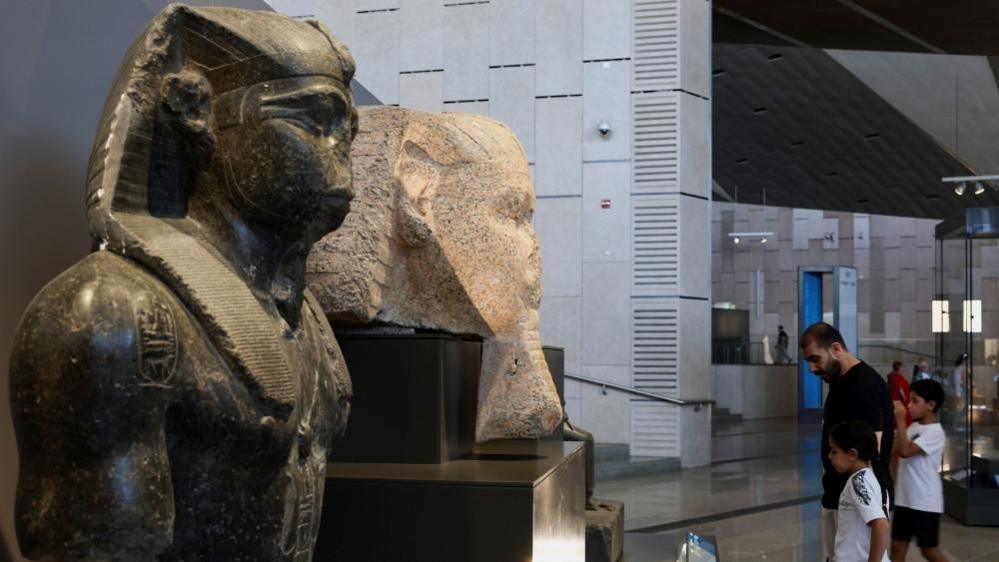
The project was hit by financial crises, the 2011 Arab Spring – which deposed Mubarak and led to years of turmoil – the Covid-19 pandemic, and regional wars.
“It was my dream. I’m really happy to see this museum is finally opened!” Dr Zahi Hawass, Egypt’s former long-time minister of tourism and antiquities, tells the BBC. The veteran archaeologist says it shows that Egyptians are equals of foreign Egyptologists when it comes to excavations, preservation of monuments and curating museums.
“Now I want two things: number one, museums to stop buying stolen artefacts and number two, I need three objects to come back: the Rosetta Stone from the British Museum, the Zodiac from the Louvre and the Bust of Nefertiti from Berlin.”
Dr Hawass has set up online petitions – attracting hundreds of thousands of signatures – calling for all three items to be repatriated.
The Rosetta Stone, found in 1799, provided the key to deciphering hieroglyphics. It was discovered by the French army and was seized by the British as war booty. A French team cut the Dendera Zodiac, an ancient Egyptian celestial map, from the Temple of Hathor in Upper Egypt in 1821. Egypt accuses German archaeologists of smuggling the colourfully painted bust of Nefertiti, wife of Egyptian pharaoh Akhenaten, out of the country more than a century ago.
“We need the three objects to come as a good feeling from these three countries, as a gift, as Egypt gave the world many gifts,” Dr Hawass says.
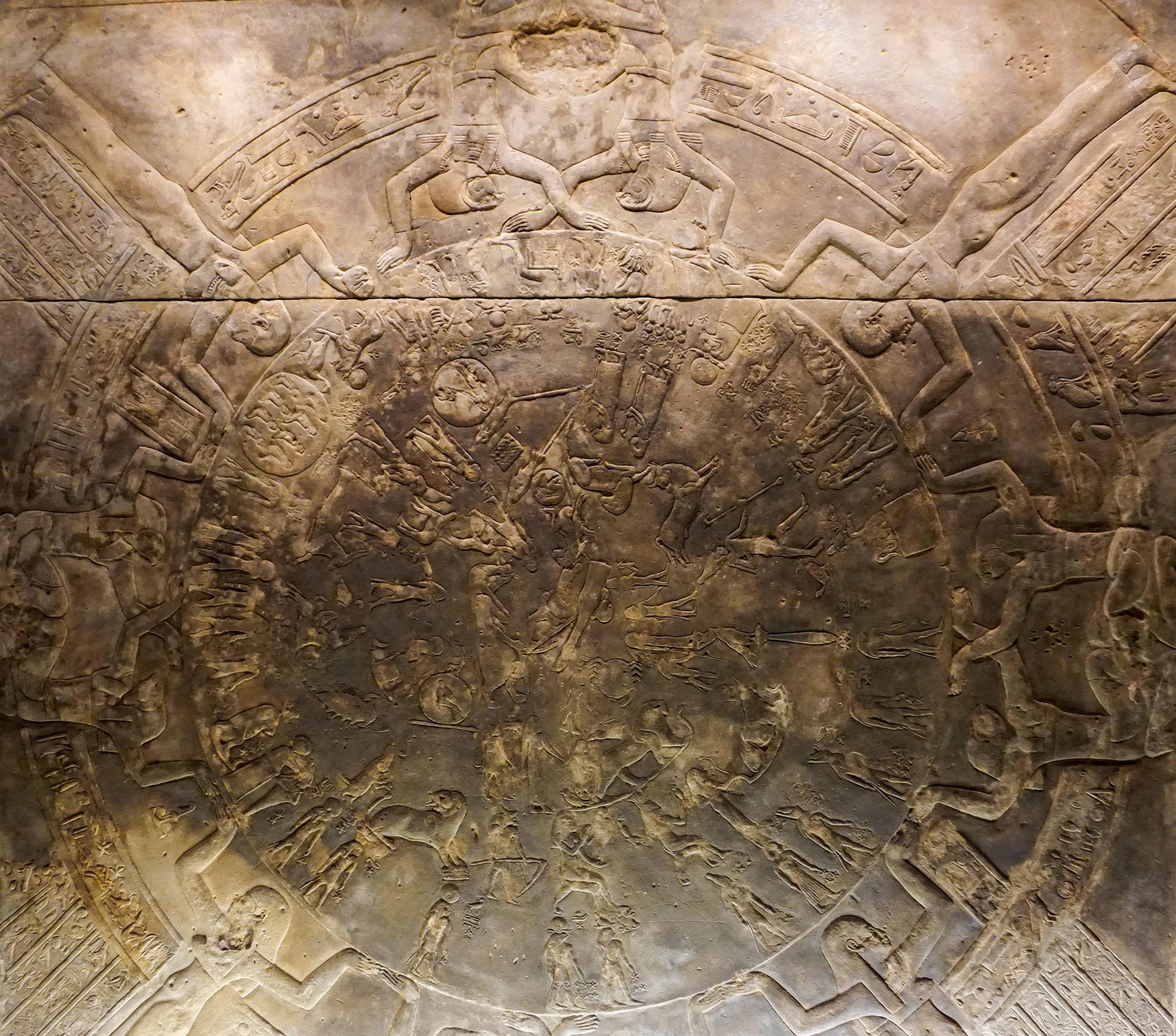
Another leading Egyptologist, Dr Monica Hanna, names the same objects, “taken under a colonialist pretext”, as ones which must be repatriated. She adds: “The GEM gives this message that Egypt has done its homework very well to officially ask for the objects.”
The British Museum told the BBC that it had received “no formal requests for either the return or the loan of the Rosetta Stone from the Egyptian Government”.
Egyptian Egyptologists voice their excitement about the new museum becoming a centre for academic research, driving new discoveries.
Already, Egyptian conservators based there have painstakingly restored items belonging to Tutankhamun, including his impressive armour made of textiles and leather. According to Egyptian law, such restorations can only be done by Egyptians.
“Colleagues from around the world have been in awe of the fantastic conservation work that has been done,” says Dr Tawfik, adding that the entire project is a source of great national pride. “As well as ancient Egyptian history, we are also showcasing modern Egypt because it’s Egypt that built this museum.”
This article is taken from BBC News https://www.bbc.co.uk/news/articles/ckg4q403rpzo
-

 Europe News8 months ago
Europe News8 months agoChaos and unproven theories surround Tates’ release from Romania
-

 American News8 months ago
American News8 months agoTrump Expels Zelensky from the White House
-

 American News8 months ago
American News8 months agoTrump expands exemptions from Canada and Mexico tariffs
-

 American News8 months ago
American News8 months agoZelensky bruised but upbeat after diplomatic whirlwind
-

 Art & Culture8 months ago
Art & Culture8 months agoThe Indian film showing the bride’s ‘humiliation’ in arranged marriage
-

 Art & Culture8 months ago
Art & Culture8 months agoInternational Agriculture Exhibition held in Paris
-

 Politics8 months ago
Politics8 months agoUS cuts send South Africa’s HIV treatment ‘off a cliff’
-

 Politics8 months ago
Politics8 months agoWorst violence in Syria since Assad fall as dozens killed in clashes


